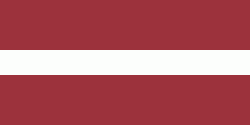Bauska District (Bauskas Novads)
Bauska District (Bauskas rajons) was an administrative division of Latvia, located in Semigallia region, in the country's centre. It was organized into a city, a municipality and fifteen parishes, each with a local government authority. The principal city was Bauska.
In the 15th century, Bauska Castle was built as a stronghold of the Livonian Order and a settlement developed around the fortification, called Vairogmiests. In 1584, Gotthard Kettler instituted a plan to remove the settlement and organize streets for a new town of Bauska, which received its town charter in 1609. The area was annexed by the Russian Empire in 1795, and an administrative unit was formed 1819 as Kreis Bauske (Бауский уезд). When Latvian independence was declared on 18 November 1918 the kreis was renamed, reorganized and included territory which is now part of Lithuania. By 1920, Bauska County (Bauskas apriņķis) included: Bauska Town and 20 parishes: Bauska, Bārbele, Brukna, Ceraukste, Code, Iecava, Īslīce, Jaunsaule, Kurmene, Mežotne, Misa, Panemune, Rundāle, Skaistkalne, Stelpe, Svitene, Taurkalne, Vecsaule, Vecumnieki, and Zālīte.
During World War II Bauska was occupied by Soviet forces and heavy fighting destroyed many of the structures of the main town. The Jewish Latvian population of the area were largely exterminated by Nazi forces and several thousand residents of the district were deported in 1941 and 1949 during political unrest. Reoccupation of Latvia by the Soviet Union at the end of World War II resulted in creation of the Bauska District (Bauskas rajons) in 1949. The Baldone parish took over administration of Iecava, Misa, Stelpe, Vecumnieki and Zālīte parishes. The Eleja parish absorbed Svitene Parish and Jaunjelgava parish added the territories of Kurmene and Taurkalne parishes.
Latvia regained its independence in 1991. The Districts of Latvia were reformed in 2009 and Bauska District was rendered defunct. It was split between the Bauska, Iecava, Rundāle and Vecumnieki municipalities.
In the 15th century, Bauska Castle was built as a stronghold of the Livonian Order and a settlement developed around the fortification, called Vairogmiests. In 1584, Gotthard Kettler instituted a plan to remove the settlement and organize streets for a new town of Bauska, which received its town charter in 1609. The area was annexed by the Russian Empire in 1795, and an administrative unit was formed 1819 as Kreis Bauske (Бауский уезд). When Latvian independence was declared on 18 November 1918 the kreis was renamed, reorganized and included territory which is now part of Lithuania. By 1920, Bauska County (Bauskas apriņķis) included: Bauska Town and 20 parishes: Bauska, Bārbele, Brukna, Ceraukste, Code, Iecava, Īslīce, Jaunsaule, Kurmene, Mežotne, Misa, Panemune, Rundāle, Skaistkalne, Stelpe, Svitene, Taurkalne, Vecsaule, Vecumnieki, and Zālīte.
During World War II Bauska was occupied by Soviet forces and heavy fighting destroyed many of the structures of the main town. The Jewish Latvian population of the area were largely exterminated by Nazi forces and several thousand residents of the district were deported in 1941 and 1949 during political unrest. Reoccupation of Latvia by the Soviet Union at the end of World War II resulted in creation of the Bauska District (Bauskas rajons) in 1949. The Baldone parish took over administration of Iecava, Misa, Stelpe, Vecumnieki and Zālīte parishes. The Eleja parish absorbed Svitene Parish and Jaunjelgava parish added the territories of Kurmene and Taurkalne parishes.
Latvia regained its independence in 1991. The Districts of Latvia were reformed in 2009 and Bauska District was rendered defunct. It was split between the Bauska, Iecava, Rundāle and Vecumnieki municipalities.
Map - Bauska District (Bauskas Novads)
Map
Country - Latvia
 |
 |
| Flag of Latvia | |
After centuries of Teutonic, Swedish, Polish-Lithuanian and Russian rule, which was mainly executed by the local Baltic German aristocracy, the independent Republic of Latvia was established on 18 November 1918 when it broke away from the German Empire and declared independence in the aftermath of World War I. However, by the 1930s the country became increasingly autocratic after the coup in 1934 establishing an authoritarian regime under Kārlis Ulmanis. The country's de facto independence was interrupted at the outset of World War II, beginning with Latvia's forcible incorporation into the Soviet Union, followed by the invasion and occupation by Nazi Germany in 1941, and the re-occupation by the Soviets in 1944 to form the Latvian SSR for the next 45 years. As a result of extensive immigration during the Soviet occupation, ethnic Russians became the most prominent minority in the country, now constituting nearly a quarter of the population. The peaceful Singing Revolution started in 1987, and ended with the restoration of de facto independence on 21 August 1991. Since then, Latvia has been a democratic unitary parliamentary republic.
Currency / Language
| ISO | Currency | Symbol | Significant figures |
|---|---|---|---|
| EUR | Euro | € | 2 |
| ISO | Language |
|---|---|
| LV | Latvian language |
| LT | Lithuanian language |
| RU | Russian language |















